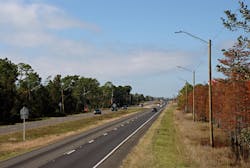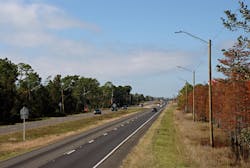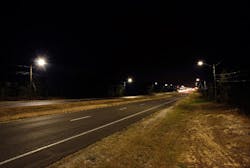Acuity Brands has announced that the Florida Department of Transportation (FDOT) and utility Gulf Power have installed close to 1000 LED luminaires from the American Electric Lighting business unit along a 19-mile stretch of highway in Santa Rosa County. The utility in Manchester, New Hampshire is recommending against a solid-state lighting retrofit of high-pressure sodium (HPS) lighting, while a utility in Cedar Falls, Iowa is pushing such a project. Mississauga, Canada is nearing the halfway point of a 50,000-light project and has documented 55% savings.
FDOT project
The Santa Rosa County, Florida project involved lighting a previously unlit section of Highway 98, the main thoroughfare that traces the gulf coast in the Florida panhandle. The installation was in the western part of the panhandle near Pensacola, and was needed to improve safety. Still, cost concerns could have derailed the project.
One key factor in making the project affordable was reuse of existing wooden utility poles that carry power distribution wiring. Installing new poles actually outweighs the cost of new fixtures, even in the case of relatively expensive LED-based products. But the existing poles were spaced irregularly and even mounting heights would have to vary over the length of the project.
Chad Luttrell, southeast regional utility sales manager, said there were quite a few challenges with the poles. The poles were set back from the road — up to 50 ft in some cases. The four-lane road is relatively wide with turn lanes that increase the demands on beam pattern. And the power lines meant that mounting heights had to be 25 ft or less on many of the poles. Luttrell said, "The project provided a multitude of challenges that other manufacturers could not meet, but American Electric Lighting was able to supply a fixture that met both FDOT and Gulf Power's expectations."
The project relied on Autobahn LED luminaires. The company supports a variety of beam patterns with the fixtures through total internal reflection (TIR) optics on each LED. Moreover, the light engines are rated for 100,000 hours of life.
"The Autobahn luminaires perform very well — especially considering the mounting challenges we faced when designing the system," said Kenneth Folsom, Gulf Power lighting services supervisor. "And we fully expect ten years of operation without maintenance."
The new lighting as delivered on much improved conditions for drivers along the highway. "We've received many positive comments regarding the lighting," said Folsom. "Roadway conditions are significantly improved and the LED luminaires have created a safer lighting environment for everyone who uses the highway."
Energy savings questions
Moving to a potential SSL streetlight retrofit in Manchester, New Hampshire, it's clear that not all utilities are on board with LED technology. Indeed, we discussed the issue of utility buy recently in another article on outdoor lighting.
The Public Service of New Hampshire utility has advised the city of Manchester that LED retrofits would only reduce energy costs by 8%, according to a story in the New Hampshire Union Leader newspaper.
The utility has said that because Manchester's existing HPS lights consume 50–70W, 40W LED luminaires would deliver only small benefits. The city, however, plans to push the utility for a more favorable electric rate, and has noted that the orange lights produced by the installed HPS fixtures generate regular complaints. We will stay tuned to this potential project.
Conversely in Cedar Falls, Iowa, the local Cedar Falls Utility made a pitch to the city encouraging the installation of LED streetlights, according to the WCF Courier website.
The utility noted that LED lighting would produce higher-quality light and that now is a good time for upgrade due to falling prices of luminaires and efficacy gains of the past year.
For lighting residential areas, the utility said it had an accepted bid of $140 per fixture. They did not identify the manufacturer. But as we covered over on our Illumination in Focus website, Cree announced a sub-$100 product in August 2013 that's targeted at residential streets. The Cedar Falls Utility also said that LEDs had been 50% more efficient than HPS lighting but that in 2013 the advantage stretched to 65%.
Mississauga results
Clearly, some municipalities have hard evidence on the energy savings attributable to LED streetlights including Mississauga, Canada in Ontario. We covered the planning stages of that city's project back in early 2011 when a complete conversion was projected to cost $33.6 million while delivering 55% energy savings and 50% maintenance savings.
According to the Mississauga.com website, the city is almost halfway through the project that will ultimately include 50,000 luminaires. With 21,000 lights installed, the city documented a reduction of 404,585 kWh of power used for lighting, essentially delivering the 55% projection.







